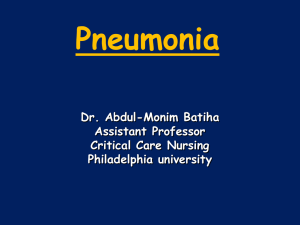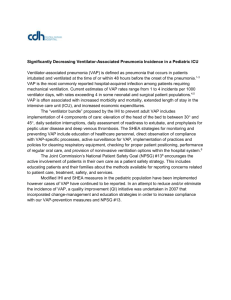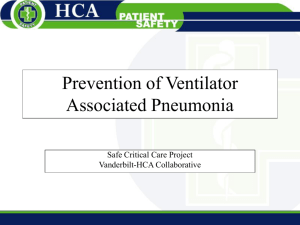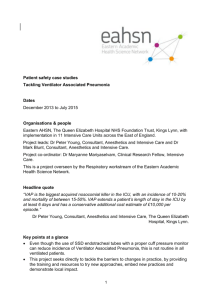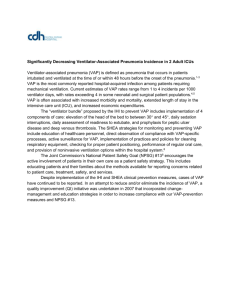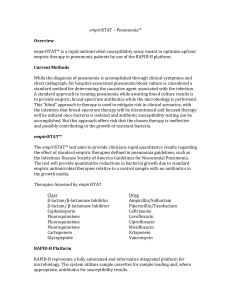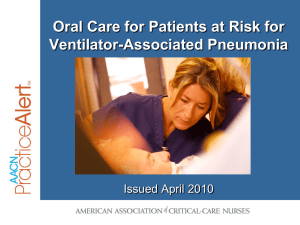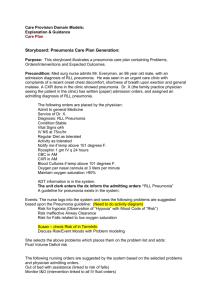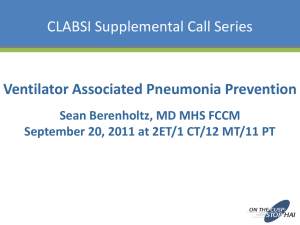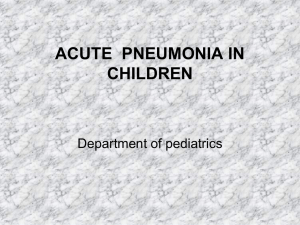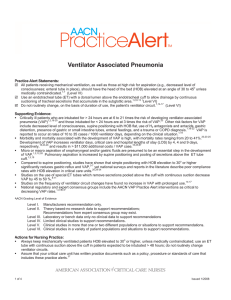John R. Zaleski, PhD, CPHIMS, Chief Informatics Officer & EVP
advertisement
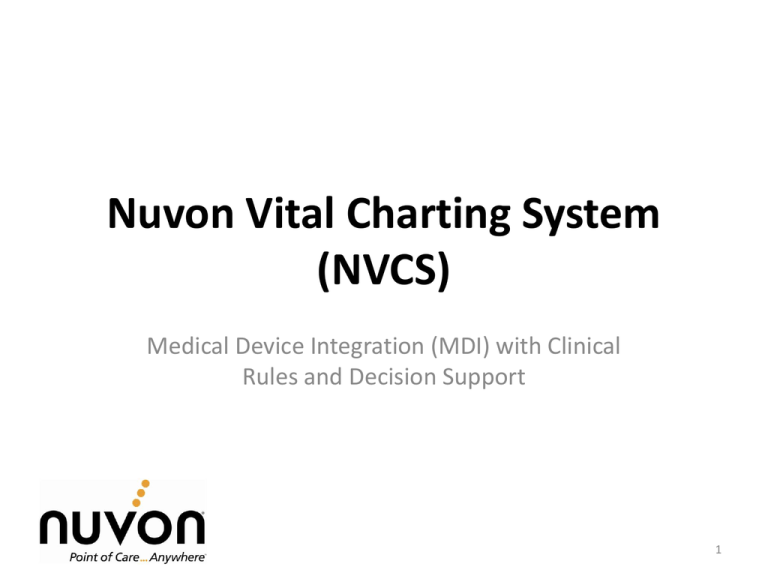
Nuvon Vital Charting System (NVCS) Medical Device Integration (MDI) with Clinical Rules and Decision Support 1 Migrating Focus of Medical Device Integration (MDI) • MDI for charting & Electronic Health Records / Electronic Medical Records (EHRs/EMRs) is the starting point, but not the ultimate objective – Use of data for near-real-time clinical use – Data availability outside of EMR/EHR framework, for research, real-time early warning notifications – Provides a more direct route to support early notification of higher acuity & higher risk patients • Nuvon is taking steps in this direction, and working with existing and new clients 2 Nuvon Medical Device Integration 3 Nuvon Vitals Charting System • Overlays existing medical device integration framework • Provides capability to store data for recall, export for a posteriori analysis. • Active rules & thresholds can operate on one or more of the medical device parameters or complex methods involving multiple parameters. • Tailored, role-based notifications and integrates with alarm management systems • The following policies apply to rules: – Simple expressions and conditions that apply to parameters so as to notify on occurrence of a condition. – Rules can be stored / recalled and used to notify on email, HL7 when certain conditions are met. – Notifications can be displayed on occurrence of a condition of one or more parameter observations received from medical devices. 4 Configuration & Components Real-Time Information Sources Vitals Specialty Medical Devices • Real-time feed from existing data sources; • Provides user-defined & default rules that can be created and managed by end users; • Can communicate to existing EHR or alarm management system; • Can provide notification visualization via Web to support call centers, handheld appliances, desktop computers Labs Rx ADT Notes Informatics Engine Enterprise EHR / Alarm Management KEY: Currently Supported Future 5 Example Use Cases • • • • Rapid Response Notification Shock index in medical / surgical patients Capnography monitoring for PCA Head-of-Bed angle compliance in mechanically ventilated patients • Rapid shallow breathing monitoring to determine viability to wean • … 6 Earlier Intervention in General Wards • “Research indicates that up to 40% of unexpected deaths in hospitals occur on the general floor. While the signs of clinical instability typically occur six to eight hours prior to an adverse event, large patient volumes and limited staffing can make it difficult for care providers in the medical surgical areas of the hospital to anticipate which patients to watch more closely.” [1] • “Up to 17% of patients in the medical surgical areas of the hospital will face an unexpected complication …in two-thirds of cases, patients demonstrate abnormal signs and symptoms within six hours of cardiac arrest, while an MD is notified only 25% of the time. [2] [1] http://healthcaresolutions.philips.com/earlier-intervention-on-thegeneral-ward#clinical [2] Bellomo R, Goldsmith D, Russell S, Uchino S. Postoperative serious adverse events in a teaching hospital: a prospective study. Med J Aust. 2002: 176:216-218 NUVON CONFIDENTIAL 7 Rapid Response Criteria NUVON CONFIDENTIAL 8 Rapid Response Notification Methods • Rapid Response Notification when patient meets multiple criteria – Superposition of multiple parameter values simultaneously, or – Additive or sum total of scoring system requirements • Rapid Response Notification based on single criteria – Individual parameters thresholds, or – Notification upon cascaded criteria (e.g.: when SpO2 < 92%, check ETCO2, …) NUVON CONFIDENTIAL 9 Rule for Rapid Response hrScore=IF(HR<=40, 2, IF(HR>40 & HR<=50, 1, IF(HR>50 & HR<=100, 0, IF(HR>100 & HR<=110, 1, IF(HR>110 & HR<=130, 2, 3))))) rrScore=IF(RR<8, 2, IF(RR>=8 & RR<=11, 1, IF(RR>11 & RR<=20, 0, IF(RR>20 & RR<=25, 1, IF(RR>25 & RR<=30, 2, 3))))) allScore=hrScore + rrScore IF(allScore>=3, 1, 0) 10 Rules for Rapid Response Scoring NUVON CONFIDENTIAL 11 Weaning, Head-of-Bed (HoB) angle management, ARDS management • On-board predictive analytics software trained on source data and subject to algorithms developed by end users. • Provide notifications and warnings based on near real-time data state in comparison with algorithmic expectations. • Provide web-based access to algorithms, data and results and tailored view of output in end-user desired formats. Note: have developed relationships (including driver) with vendor partners such as Covidien, Sizewise (beds) to support more complex workflows involving critical patient data 12 Increasing Rates of HoB Compliance Linked to Reduced VAP Ventilator-associated pneumonia (VAP) is the most common hospital-acquired infection in the intensive care unit (ICU). [1] It occurs in 9% to 40% of all ICU patients and has an incidence of 5 to 35 cases per 1000 ventilator days. [2] The consequences of VAP are severe: a three-fold increased duration of mechanical ventilation, a two- to six-fold increase in ICU stay, a 2- to 3-day increase in hospital stay. [3] Each case of VAP increases hospital costs by $40,000 to $50,000 and results in a 15% to 45% increase in attributable mortality. [2,4] Elevation of the head-of-bed (HOB) of intubated patients is an effective method for reducing rates of aspiration pneumonia. In a randomized two-period crossover study, Torres et al. [5] demonstrated that the semirecumbent position decreased rates of aspiration of gastric contents four-fold. Kollef [6] A Simple Device to Increase Rates of Compliance in Maintaining 30-Degree Headof-bed Elevation in Ventilated Patients Zev Williams, MD, PhD, Rodney Chan, MD, Edward Kelly, MD DisclosuresCrit Care Med. 2008;36(4):1155-1157. 13 Modified Shock Index 14 Rapid Shallow Breathing Index 15 16 Chart View 17 Chart View, Trending, Thresholds 18 John R. Zaleski, Ph.D., CPHIMS Chief Informatics Officer Nuvon, Inc. 4801 S. Broad Street Suite 120 Philadelphia, PA 19112 E: jzaleski@nuvon.com T: @johnrzaleski O: 215-600-2627 x102 THANK YOU 19 References 1. 2. 3. 4. 5. 6. 7. 8. 9. 10. 11. 12. 13. Vincent JL, Bihari D, Suter PM, et al: The prevalence of nosocomial infection in intensive care units in Europe: Results of the European Prevalence of Infection in Intensive Care (EPIC) Study. EPIC International Advisory Committee. JAMA 1995; 274:639-644 Ibrahim EH, Tracy L, Hill C, et al: The occurrence of ventilator-associated pneumonia in a community hospital: Risk factors and clinical outcomes. Chest 2001; 120:555-561 Rello J, Ollendorf DA, Oster G, et al: Epidemiology and outcomes of ventilator-associated pneumonia in a large US database. Chest 2002; 122:2115-2121 Tablan OC, Anderson LJ, Besser R, et al: Guidelines for preventing health-care-associated pneumonia, 2003: Recommendations of CDC and the Healthcare Infection Control Practices Advisory Committee. MMWR Recomm Rep 2004; 53:1-36 Torres A, Serra-Batlles J, Jos E, et al: Pulmonary aspiration of gastric contents in patients receiving mechanical ventilation: The effect of body position. Ann Intern Med 1992; 116:540-543 Kollef MH: Ventilator-associated pneumonia: A multivariate analysis. JAMA 1993; 270:1965-1970 Drakulovic MB, Torres A, Bauer TT, et al: Supine body position as a risk factor for nosocomial pneumonia in mechanically ventilated patients: A randomised trial. Lancet 1999; 354:1851-1858 Critical Care. http://www.ihi.org/IHI/Topics/CriticalCare/ . Accessed October 26, 2007 Curtis JR, Cook DJ, Wall RJ, et al: Intensive care unit quality improvement: A how-to guide for the interdisciplinary team. Crit Care Med 2006; 34:211-218 Evans D: The use of position during critical illness: Current practice and review of the literature. Aust Crit Care 1994; 7:16-21 Grap MJ, Munro CL, Bryant S, et al: Predictors of backrest elevation incritical care. Intensive Crit Care Nurs 2003; 19:68-74 van Nieuwenhoven CA, Vandenbroucke-Grauls C, van Tiel FH, et al: Feasibility and effects of the semirecumbent position to prevent ventilatorassociated pneumonia: A randomized study. Crit Care Med 2006; 34:396-402 McMullin JP, Cook DJ, Meade MO, et al: Clinical estimation of trunk position among mechanically ventilated patients. Intensive Care Med 2002; 28:304-309 20
